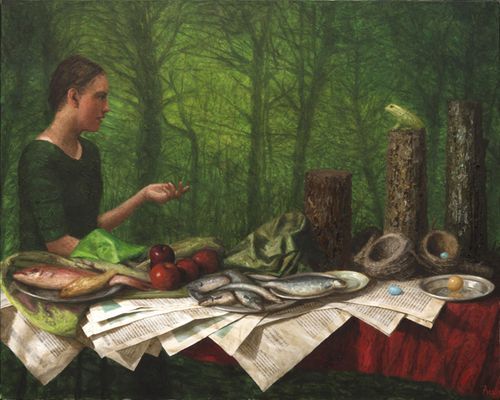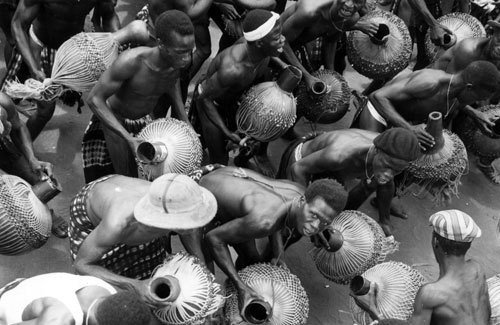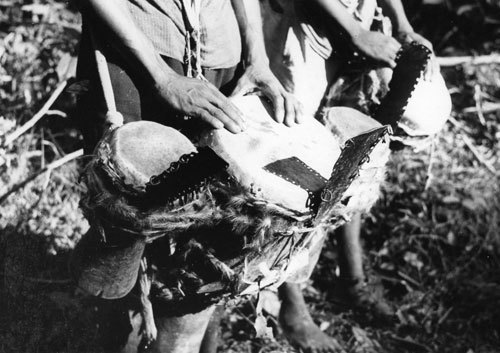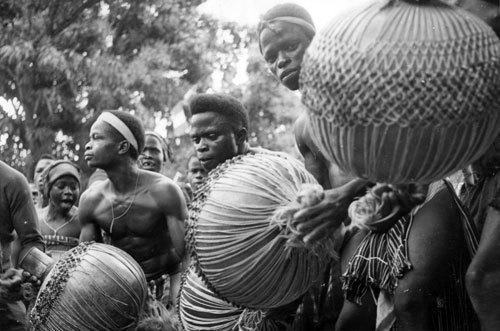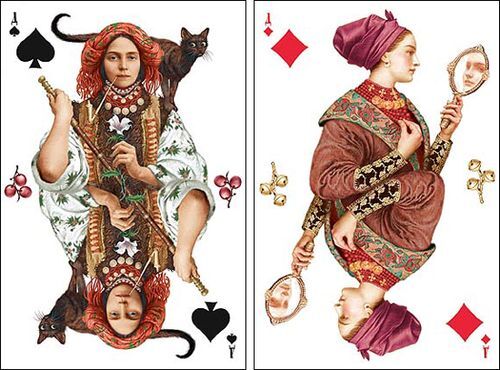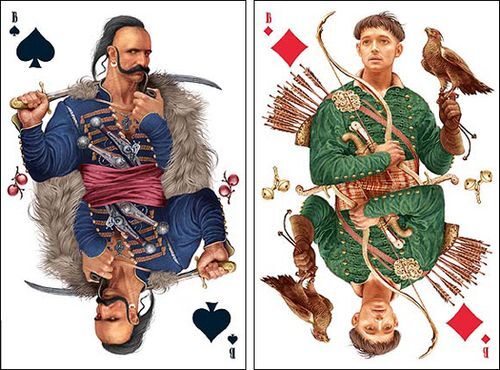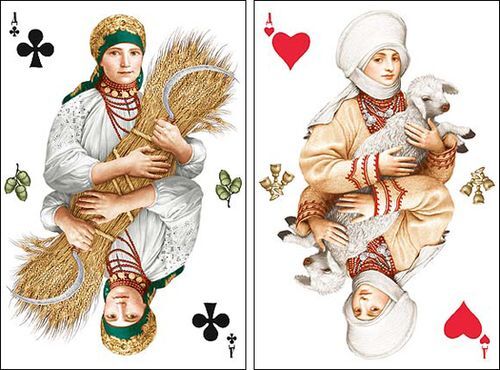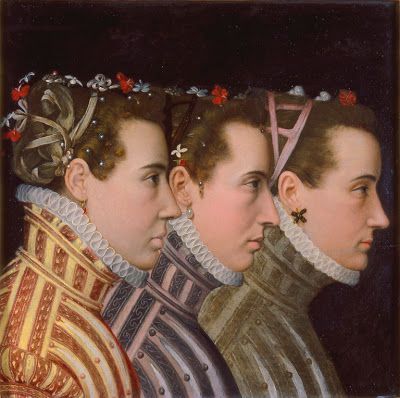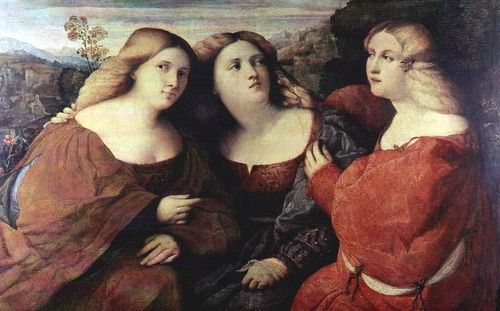Midori Snyder's Blog, page 3
August 7, 2023
People Inconvienced by Objects and Thoughts
I love these wildly imaginative graphite portraits by Stefan Zsaitsits of People Inconvenienced by Objects and Thoughts. They look almost exactly how my head feels right after a day of juggling too many things and trying to get some writing squeezed in somewhere. Though it does look like this may be the only writing I manage here for today anyway.
August 4, 2023
Katherine Ace: The Open Ended Metaphor
I am bringing an old post back because I wanted to review again the fabulous discussion on women's art, especially the work of Katherine Ace and the events that surround and shape the direction of women's lives. And re-reading it again, I still find it as fascinating and with much to offer as when we first tackled the subject. Please feel free to join this ongoing discussion in the comments below.
The structure of fairy tales and traditional folklore rests on the use of repetition to pattern the images into metaphors providing an emotional experience of transformation for the audience in the oral traditions and for the reader following them in print. Storytellers use repetition to shape the story and emphasize important details in each section of the tale. It begins with an interdiction at the home of birth, a repeated request to do or not to do something, which is usually ignored by the third time. The middle section is a stripping away of identity and connection to the human world, with the protagonist becoming lost in the woods, the veld, the sky, and the sea. Swallowed up and sometimes ingested by the elements of nature and the fantastic.
Repetition helps to parallel the experience of the two separate moments: the repeated interdiction of "don't " becomes a new list in the middle of what must be done to survive. Feed the cat, oil the gate, and clean an old woman's eyes. But a price is paid, sometimes even a temporary death, as the old identity is stripped, and a new one is reformed in the fantastic world. And the last section becomes the return home, often perilous, success dependent on how well nature has communicated the rules of survival and how well they are followed. If in accordance with nature, the protagonist returns, restored to a new identity, a new status, and a new purpose.
Each section of the narrative -- separation, initiation, return-- is patterned in a parallel fashion to the other. As in metaphor, there is a delightful tension between where it begins, where it meets with the impossible, and where it sublates the changes to become something new and unique. The dialectical journey in rites of passage, the death of the old identity, the reforming and re-emergence of a new identity, are combined into a single metaphor of transformation, revealed through images from the human world, the fantastic world, and the cache of inherited cultural archetypes in the narrative performance.
All this is to explain, why I am so taken by the fairy tale art of Katherine Ace, who expresses her work with fairy tales in a very similar fashion -- painting the narrative with a series of visual metaphors folding in on themselves to express the unstable identities of the tales. She says this in her artist's statement:
"The intersection of contraries fascinates me: ecstasy and agony; humor and tragedy; natural and constructed realities; experience and news. I find that I'm curious about the struggles of diversity vs. unity in human, animal and plant societies. I am captivated by complex issues that we all face, and yet experience personally, intimately. I am interested in the role of dark feelings, thoughts and states of mind in the process of transformation, l am drawn to fire beneath reserve."
And again here when she considers the evocative imagery in fairy tales that fuels her ideas as an artist:
"I am interested in complex story telling using cultural myths and histories that reach back into our collective and personal pasts. Figures and still life figures evolve as open ended metaphors for concepts and environments that are themselves also metaphors, and therefore fold - like fabric, time, or paint - back in on themselves. Like a poem, a painting is a surface. The depth is in the surface (oddly). It sort of dawns on you - like the way one remembers a dream sometimes, in fragments that float up all through the day, assembling themselves oddly, disturbingly..."
I find this description compelling -- for it is in the story tellers performance, or the writer of fairy tales to create the same tension between the surface of the tale, and the dream-like, metaphorical journeys as real and fantastic collide in the stories, and that it is the experience itself -- dreamlike and disturbing that holds our fascination with the tales.
The paintings from top to bottom: "The Juniper Tree," "The Frog King," "The Handless Maiden," "Six Swans," and "Many Furs." (All my favorite tales!) For more information on Katherine Ace please visit her website.
I also found the collection of Sicilian Folktales collected by Laura Gonzenbach, translated into English. They are amazing and she was quite interesting.
Donald Hall: One Road

(Photos by Peter Zelei/istockphoto and John Robert Shepard)
This happened across my internet-desk one morning and I stopped everything to read it. The poet Donald Hall wrote a beautiful and very poignant essay "One Road" about a journey he took post WWII with his very young bride driving from Oxford to Greece, by way of Yugoslavia. It is one of those effortless pieces of writing, that immediately draws you in and holds you captive to the end of the journey. It conveys the desire (and fearlessness) of the young to travel as a form of self discovery. It is also a detailed travelogue of a world now much changed, and a graceful reflection on a life that is only possible from a great distance (Hall wrote this essay when he was 84). Take a moment and enjoy.
"In December of 1952 my first wife, Kirby, and I left Vienna to drive through the Russian sector of Austria into Yugoslavia. At the border crossing, on a two-lane macadam road with no other car in sight, we stopped to present documents that permitted us to enter Marshal Tito���s country. Walking back to our car afterward, we met a man heading in the opposite direction, toward Austria. He had emerged from a big black car, and he looked important, like a diplomat or a capo. Seeing the initials of national origin on our small Morris convertible, he addressed us in English. I held in my hand our confusing travel directions. We asked the man if Zagreb was straight ahead.
He shrugged, and told us, ���There is only one road in Yugoslavia.���
July 21, 2023
Putting Together My Father's Research With The Photos: West Africa 1963-64
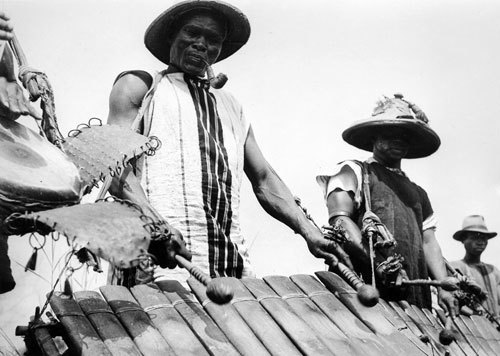 Balafon performance in the streets of Conakry, Guinea. ��1963 Emile Snyder
Balafon performance in the streets of Conakry, Guinea. ��1963 Emile Snyder
Among the amazing documents that have floated my way over the years was a manilla folder full of gorgeous black and white photographs my father took in the Ivory Coast (well..they were developed there and some of them might have been also taken in Senegal, Mali, or Guinea). Among my mother's papers that I received after her death was a carefully cached collection of letters that my parents had written to each other during fall 1963 to spring of 1964, when they were both abroad on Ford and Fulbright grants-- he to numerous countries in West Africa and she to India, Bhutan, and Sikkim.
The letters are very interesting, and cringe worthy in places. One third love letters (with some surprising revelations about their sex life I could have survived never knowing about), one third about money (there was never enough and what there was always came late allowing for some desperate nail biting) and one third talking about the research and the separate lives they were having on their different continents.
As I read through the research parts of my Dad's letters, I learned a lot about these photographs--especially that he had done many field recordings of musicians, griots, and small village brass bands. He had made friends with many African writers at the very start of their careers as authors in 1963, he had met and become friends with Leopold Senghor, President of Senegal, and other writers and poets turned diplomats -- who also gave him music tapes and recordings (especially the radio stations eager to get their music out to the West as well as Africa.). He sent 25 or so tapes back to the states with friend and ethno-musicologist Robert Garfias who returned them to the Ethnomusicology Archives at the University of Washington, Seattle, WA.
I went looking for the tapes in the archives -- as this was the first I knew that they had been properly given over to someone. I was so excited to find them listed here and here. So I will be sending scans of all the photos (plus more of the notes I discovered in his letters) to the archive there -- delighted that future students will have a chance to see these images and connect them to the music on the tapes. In many ways, the best part of finding all these papers is being able to share the really great parts of their careers with others -- to share those moments in history where they saw something, heard something, or wrote something that still matters.
All the photos can be found here -- or by clicking the link to "West African Musicians" in the left hand side bar. And all photos are ��1963 Emile Snyder -- please email me at the blog to request permission to use these photos.
July 19, 2023
Ukranian Illustrator Vladislav Erko: Playing Cards And Fairy Tales
I am swooning at these exquisite and detailed playing cards created by Vladislav Erko, a Ukranian illustrator noted for his equally beautiful and lush work in children's fairy tale books. Each card reflects a careful study of Ukrainian costumes as well as traditional implements, tools, and instruments. And I love the engaging faces of the characters that decorate the cards -- at once robust, wry, and seductive. While Erko doesn't appear to have a personal website, more information can be found at "Fairy Tales Images of Vladislav Erko" (which includes his gorgeous "Snow Queen" illustrations among many others).
And here are a few illustrations from Erko's "The Tales of Foggy Albion British Knight Tales" illustrations that knock me back with their almost surreal backgrounds, exquisite details, and nod to the Renaissance and Pre-Raphaelite sensibilities.
July 14, 2023
in the Labyrinth: Excerpt from the Innamorati Rehearsal
The Commedia dell' Arte in the 16th century was a vigorous form of theater, and a largely improvised theater, with established stock plots and bits of commedic exchange that employed a free flowing rehearsal -- a chance to invent and reinvent the plays so the performances remained fresh and current to their audiences. For the actors who performed the roles of the different Zanni (the clowns) there were physical demands, requiring agility and athleticism. In the background, there was an on-going apprenticeship with the children of the actors to acquire experience and understanding of their parent's craft and carry the troupe into the next generation.
Beneath a star-studded sky, the maestro of the Libertini studied his actors and pondered the next two weeks. Alberto Torelli was a tall, well-built man. Though in his forties, he carried himself like an athlete. His black hair, salted with grey at the temples, was thick and wavy. He had an expressive face, with arched eyebrows poised over intense, dark eyes. He wore a neatly trimmed mustache and goatee, which he stroked as he thought about their plans. In a month the Libertini would perform in the wealthy palazzos of Milan's nobles. There they would find a much better reception than at this rude seaside camp where they were now. But Alberto knew that his company needed the journey along the coast to develop new plays. They needed more rehearsals and the opportunity to experiment in front of rougher audiences. If these villagers laughed, if they wept and applauded, then Alberto knew his troupe could proceed with confidence to the more daunting audiences of the nobility.
Alberto had high hopes for this company. It was a good mix of experienced hands and energetic newcomers. From Milan they would go west to Turin, and then across the border into France. There, with the right letters of introduction, they would be able to make a comfortable season for themselves.
Alberto glanced at his wife, Isabella, where she sat reading a book of poetry. She was radiant in the glow of firelight, her skin the color of ivory, her long golden hair rippling over her soft, rounded shoulders. Even in the crude camp of wagons and horses, she maintained an aura of elegance. She sat on rugs amid Turkish pillows, her tiny feet encased in embroidered slippers. Isabella was born a prima donna, an Innamorata who could seduce the audience simply by her feminine presence. Alberto had never been happier in his life than the day she had consented to marry him.
As if feeling the warmth of his stare, Isabella glanced up from her book and smiled. Alberto felt his knees go weak. She kissed a pearl-colored fingertip and blew the kiss to him before returning to her book. Alberto caught the kiss and touched his fingers to his own lips. Beyond Isabella sat Fiammetta, who was nursing her baby daughter, Rosella. Fiammetta was married to Flavio Fiorillo, the actor working on the role of II Dottore. Sitting next to her was Alberto s daughter, Silvia, practicing a singing duet with Fiammetta. At sixteen, Silvia was already a charming young woman. But where her mother, Isabella, was golden, Silvia was raven-haired, like Alberto. She had expressive dark eyes and a pouting red mouth.
"I'm going to kill you for that!"
Alberto smiled, watching the antics of Gianni Moretti and Bruno Pasquati rehearsing a scene between the blustering II Capitano and the scrappy king of insults, Pulcinella. The upper halves of their faces were covered by black leather masks with huge black noses and rumpled foreheads. Bruno, playing Pulcinella, wore a tall dusty fez, while Gianni, as II Capitano, had a sweeping mustache that puffed out with every word he spat. The two actors swaggered with huge pot bellies, their shoulders thrust back as they traded insults
Daniel Mitsui: Bookplates
I discovered Daniel Mitsui , an American-Japanese artist through one of my favorite blogs that has now sadly has disappeared. Mitsui is an artist in Chicago who concentrates on sacred artwork in the medieval tradition as well as biological illustrations. His work, painstaking and gorgeous black and white illustrations, are all done in pen and ink and by hand. I have posted an example of his beautiful bookplates

The beautiful color work below is Mitsui's Japanese vision of the Angels' battle against Satan.
Inspiration in Threes
I have been working on two major projects simultaneously -- a novel about Zizola, one of the heroines of The Innamorati, which will be something of a sequel, and Three Sisters -- a loosely attached third novel in the series based on an Italian folktale "Three Princesses Wed To Passers-Bye." As I work, I collect images that speak to me in some way -- evocative and sometimes provocative about the characters of the novels. I have a pinterest board where I keep most of the images for these two novels and here are some that I especially like of Three Sister-ness keeping them on my desk top so they are the first thing I see when I boot up the computer. I like the way the sisters are arranged -- close in body and in age -- the tension of being of the same root, and yet trying to be distinct. It makes for an interesting story.
Art/Photos: Lucas de Heere, 'Triple Profile Portrait', ca. 1570, Palma Vecchio,"The Three Sisters", c. 1520, The Levy Sisters, a vaudeville team. Photographer,Newsboy, 1890, Vintage photograph 1905.
Tintoretto and The Origin of the Milky Way
This is a really gorgeous painting by Jacopo Tintoretto depicting the "Origin of the Milky Way, 1575-1580." Jupiter (Zeus) seeks to give immortality to his son, Hercules, conceived during an illicit affair with a mortal woman Alcmene. He knows that only the breast milk of a goddess can accomplish such a thing and as luck would have it Juno (Hera) is lactating. Jupiter discovers Juno sleeping and attempts to latch the baby to her breast -- thinking she might not notice (really? ) When she wakes and pulls her breast away from the feeding infant, her milk sprays into the heavens and produces the stars. (Click on the image to see a larger version)
Here is a wonderful and incredibly informative little podcast about The Origin of the Milky Way from Karen Allen of the National Gallery in England exploring the wealth of creation myths alluded to in the painting (including the origin of lillies) and lovely details about Tintoretto's artistic storytelling. It's fabulous.
Basile's Remarkable Introductions to the Tales
Would that I could begin a novel with such splendid introduction as this frame story for Basile's entire collection of tales:
"It is an established proverb, one of ancient coinage that he who seeks what he shouldn't, finds what he doesn't wants; and it is known that the monkey, by shoeing himself with boots, remained caught by the feet, as happened to a ragged slave who never having worn shoes on her feet, wanted to put a crown on her head. But because the grindstone takes off all the rough spots, and there comes a day when everything is paid for, in the end she who by evil ways had usurped what was meant for others, was caught in the wheel of kicks and the higher she had risen to the top, the greater was her precipitous fall..."
What I love about this quote is how well it describes an archetypal character in many folktales from many cultures: the false bride whose role is to assume temporarily the part meant for the true bride, while at the same time giving the true bride an opportunity to complete her rite of passage before making herself known to the groom. The false bride is usually pretty ugly, or in the case of Basile's frame story she is a "cricket-legged slave girl" --and sufficient to make the groom miserable until he discovers the true bride at last.
Midori Snyder's Blog
- Midori Snyder's profile
- 87 followers




